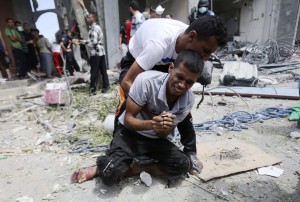
When the negotiated 72-hour ceasefire between Israeli occupation and Palestinian resistance forces broke down after just two hours on August 1, President Obama and UN Secretary General Ban Ki-Moon immediately blamed Hamas. The supposed cause of the breakdown was a battle that took place near Rafah in southern Gaza that resulted in two Israeli soldiers killed and one allegedly captured.
But it turns out that the accounts which Obama and Ban so quickly rushed to embrace and promote were fabricated by the Israeli leadership. The Israelis had agreed to the ceasefire under heavy international pressure, but clearly wanted to continue their deadly offensive. At the same time, the Israeli leaders sought – as they have done so often in the past — to deflect responsibility for their actions by portraying themselves as victim and the Palestinians as aggressor.
White House spokesperson Josh Earnest told the media on Aug. 1: “Apparently, Hamas individuals used the cover of a humanitarian ceasefire to attack Israeli soldiers and even to take one hostage. That would be a rather barbaric violation of the ceasefire.”
It should be noted that the term “barbaric” is never used by U.S. leaders in connection with the massacring of Palestinians, even the destruction of entire families by Israeli bombs and missiles.
Obama said it was “not particularly relevant” whether Hamas or another group was behind the reported kidnapping of the Israeli soldier. “The point is, when they sign on to a ceasefire, they’re claiming to speak for all the Palestinian factions,” he said.
When politicians use words like “apparently,” and say that it’s “not particularly relevant” if those they are accusing actually did what they are accused of, it is pretty clear that they are making it up as they go along.
And they were.
Accounts since by the U.N., Hamas and the Israeli newspaper Ha’aretz paint a very different picture of what happened. Terms of the ceasefire stated that Israeli troops could remain for the 72 hours of the truce in the positions they held at 8 a.m. Gaza time on August 1.
At 6 a.m., an Israeli unit which had been about 200 yards inside the border at Rafah for some time, suddenly advanced to 1.5 miles inside Gaza, according to the military correspondent for Ha’aretz. To launch such an operation so close to the start of a ceasefire was clearly provocative.
The ostensible military objective was seizing as much territory as possible before the ceasefire took effect. At around 7 a.m., however, the Israelis encountered Hamas forces and a battle ensued. At 7:34 a.m, the Qassam Brigades, military wing of Hamas, tweeted, “We just did a major operation against Israeli forces in Rafah, and we killed several of them.”
Israel claimed that this incident took place at 9:30 a.m., 90 minutes after the ceasefire was supposed to take place and launched a massive assault on Rafah that is continuing today, killing and wounding hundreds. The pretext for this particular attack was rescuing the “captured soldier,” who was actually killed in the battle or by Israeli bombing of the area.
On the August 4 Democracy Now program, renowned Palestinian journalist Mohammed Omer described the humanitarian situation in Rafah as “terrifying,” telling of commercial freezers and coolers filled with the bodies of civilians including many children, and acute shortages of water and other necessities.
As of August 4, more than 1,800 Palestinians have been killed and more than 8,500 wounded, the vast majority civilians. At least 16 extended families have been wiped out. On the Israeli side, 66 have been killed, 63 of them soldiers.





